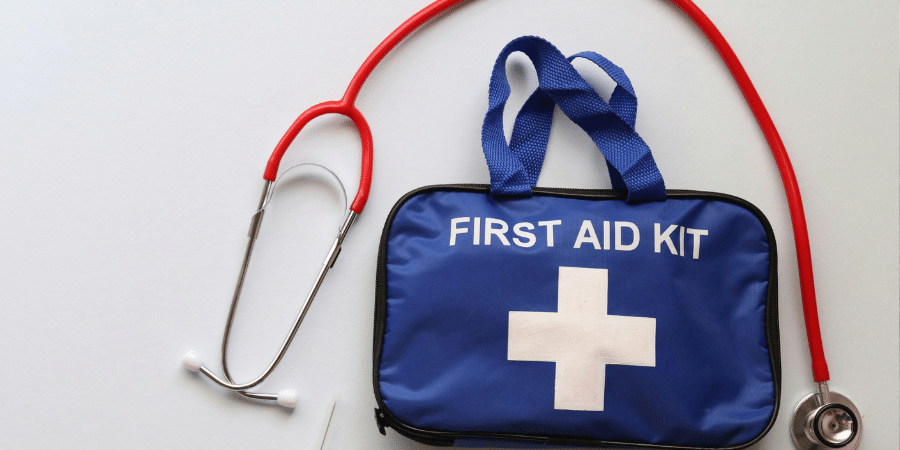Because young children are inherently curious and active, accidents and emergencies can occur at any time. Parents must be ready with rudimentary first aid knowledge to protect their child’s safety and well-being. This article covers essential first-aid techniques and advice for all parents.

Create a First Aid Kit
A well-stocked first aid kit is a must-have in every home. Your first aid kit should include
- Adhesive bandages in various sizes
- Antiseptic wipes and cream
- Sterile gauze and adhesive tape
- Tweezers and scissors
- Thermometer
- Pain relievers suitable for children (e.g., paracetamol or ibuprofen)
- Instant cold packs
- CPR face shield or mask
- Emergency contact information
Your kit should be stored in an easily accessible location, and check it regularly to ensure supplies are not expired and are replaced after use.
Learn CPR for Infants and Children
Cardiopulmonary resuscitation (CPR) can save a child’s life in emergencies such as choking or drowning. Learning how to do this is very key for parents with kids. Key steps include:
- For infants (under 1 year): Use two fingers to perform chest compressions at the center of the chest, about 1.5 inches deep, at a rate of 100-120 compressions per minute. Provide gentle rescue breaths.
- For children (over 1 year): Use one or both hands for chest compressions, about 2 inches deep, at the same rate as above. Follow with rescue breaths if trained.
If you would like to learn how to do this professionally, it is advisable to consider taking a certified CPR course to practice these techniques under professional guidance. There are many online and in-person training programs available everywhere. You can find training here: https://cpr.heart.org/
Treating Cuts and Scrapes
For minor wounds, take the steps below to give first aid treatment to your kids. Firstly, wash your hands to prevent infection. Rinse the wound under clean, running water to remove dirt. Apply antiseptic cream and cover with a sterile bandage and then monitor for signs of infection, such as redness, swelling, or pus.
Seek medical attention if the wound is deep, won’t stop bleeding, or was caused by a dirty object.
Handling Choking
Choking is a common emergency in young children. Sometimes it happens when you are eating and drinking. Always act quickly if your kid belongs to the below categories:
- For infants (under 1 year):
- Lay the baby face down along your forearm, supporting their head.
- Deliver five firm back blows between the shoulder blades.
- If ineffective, turn the baby face up and perform five chest thrusts using two fingers.
- For children (over 1 year): Perform abdominal thrusts (Heimlich maneuver) by placing your fist above the child’s navel and pulling in and up sharply.
Call emergency services if the object doesn’t dislodge.
Managing Burns
For minor burns:
- Cool the burn under running water for at least 10 minutes.
- Avoid using ice or greasy substances.
- Cover with a non-stick, sterile dressing.
- Administer pain relief if needed.
Seek immediate medical help for severe burns, burns covering a large area, or those on the face, hands, or genitals.
Dealing with Fevers
Fevers are common in young children and are often a signal that the body is fighting an infection. To manage a fever:
- Use a thermometer to monitor the temperature.
- Dress the child in lightweight clothing and keep the room cool.
- Offer fluids to prevent dehydration.
- Administer age-appropriate fever reducers if the child is uncomfortable.
Consult a doctor if the fever persists for over two days, is very high (over 39°C or 102.2°F), or is accompanied by other symptoms like a rash or difficulty breathing. You can read more here: https://www.aap.org
Responding to Allergic Reactions
Signs of an allergic reaction can range from mild (rash, itching) to severe (anaphylaxis). For severe reactions:
- Administer an epinephrine auto-injector (if prescribed).
- Call emergency services immediately.
- Keep the child calm and seated until help arrives.
For mild reactions, use antihistamines and monitor closely.
Handling Poisoning
If you suspect your child has ingested a harmful substance:
- Keep the child calm and seated.
- Call a poison control center or emergency services immediately.
- Do not induce vomiting unless advised by a professional.
Keep medications, cleaning products, and other dangerous substances out of reach to prevent poisoning.
The Common Cold
The common cold is one of the most frequent childhood illnesses, especially during winter. You can care for your kids by understanding the symptoms and how to care for it.
- Symptoms: Runny or stuffy nose, sneezing, cough, mild fever, sore throat.
- Home Care: Ensure rest, offer plenty of fluids, and use saline nasal drops.
- When to Seek Help: If symptoms worsen, high fever develops, or breathing becomes difficult.
To learn more about how to care for the common cold, read more here.
Know When to Seek Professional Help
It’s essential to recognize when an injury or illness requires medical attention. Call a doctor or emergency services if your child:
- Has trouble breathing
- Loses consciousness
- Shows signs of a severe allergic reaction
- Has a deep wound, severe burn, or broken bone
- Appears lethargic or unresponsive
Educate and Empower Yourself
Taking a first aid course specifically for children can give you the confidence to handle emergencies effectively. Many local organizations offer workshops for parents and caregivers.
By equipping yourself with these first aid essentials, you can be better prepared to protect your child and provide immediate care during unexpected situations. Remember, staying calm and acting quickly can make all the difference.